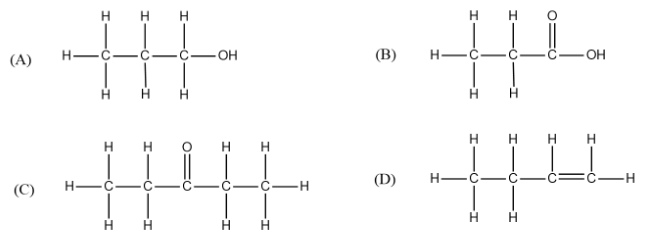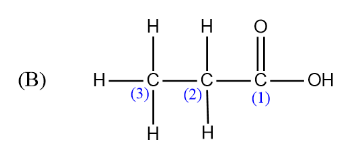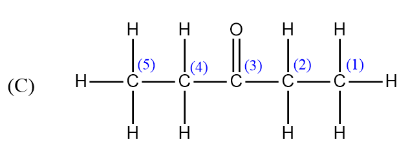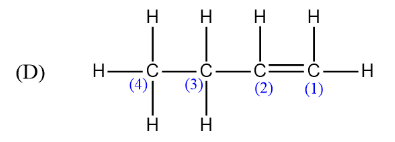
Identify and name the functional groups present in the following compounds.


Answer
498.3k+ views
Hint : the compounds are given in expanded form; use the IUPAC (International Union of Pure and Applied Chemistry) system of nomenclature to name all the compounds. The functional groups are easy to identify in the above compounds. The above compounds have only one function attached to them.
Complete Step By Step Answer:
We are given four compounds written in expanded form in the question, and we have to write their names and even identify the functional group attached to them.
For naming the structures IUPAC system of nomenclature is followed. There are certain rules under IUPAC nomenclature. They are as follows:
Find out the longest chain. It is termed as the parent chain
Identify all the groups attached to it.
Start numbering the parent chain, starting at the end nearest a substituent group.
Allocate the location of each substituent group by an appropriate number and name.
Assemble the name, listing groups in alphabetical order.
Use prefixes di, tri, tetra etc. if more than one group is present of the same kind. Place dash between numbers and name and comma between multiple numbers.
Now using the above rules write the name of the above compounds.

The name of this compound is propane- $ 1 $ -ol or propanol. The functional group present in this compound is alcohol.

The name of this compound is Propan- $ 1 $ -oic acid mainly written as propanoic acid. The functional group present in this compound is carboxylic acid.

The name of this compound is Pent- $ 3 $ -one or $ 3 $ -pentanone. The functional group present in this compound is ketone. In this compound numbering can be done from both the sides as in both ways the functional group is present in the $ {3^{rd}} $ position.

The name of this compound is But- $ 1 $ -ene or Butene. The functional group present in this compound is alkene.
Note :
Parent chain is the longest carbon chain which has functional groups attached to it. And the rest groups attached to the parent chain become the substituent. If compounds are simpler than IUPAC names, common names can be used. Following the rules to give the IUPAC name to the compound is important.
Complete Step By Step Answer:
We are given four compounds written in expanded form in the question, and we have to write their names and even identify the functional group attached to them.
For naming the structures IUPAC system of nomenclature is followed. There are certain rules under IUPAC nomenclature. They are as follows:
Find out the longest chain. It is termed as the parent chain
Identify all the groups attached to it.
Start numbering the parent chain, starting at the end nearest a substituent group.
Allocate the location of each substituent group by an appropriate number and name.
Assemble the name, listing groups in alphabetical order.
Use prefixes di, tri, tetra etc. if more than one group is present of the same kind. Place dash between numbers and name and comma between multiple numbers.
Now using the above rules write the name of the above compounds.

The name of this compound is propane- $ 1 $ -ol or propanol. The functional group present in this compound is alcohol.

The name of this compound is Propan- $ 1 $ -oic acid mainly written as propanoic acid. The functional group present in this compound is carboxylic acid.

The name of this compound is Pent- $ 3 $ -one or $ 3 $ -pentanone. The functional group present in this compound is ketone. In this compound numbering can be done from both the sides as in both ways the functional group is present in the $ {3^{rd}} $ position.

The name of this compound is But- $ 1 $ -ene or Butene. The functional group present in this compound is alkene.
Note :
Parent chain is the longest carbon chain which has functional groups attached to it. And the rest groups attached to the parent chain become the substituent. If compounds are simpler than IUPAC names, common names can be used. Following the rules to give the IUPAC name to the compound is important.
Recently Updated Pages
Why are manures considered better than fertilizers class 11 biology CBSE

Find the coordinates of the midpoint of the line segment class 11 maths CBSE

Distinguish between static friction limiting friction class 11 physics CBSE

The Chairman of the constituent Assembly was A Jawaharlal class 11 social science CBSE

The first National Commission on Labour NCL submitted class 11 social science CBSE

Number of all subshell of n + l 7 is A 4 B 5 C 6 D class 11 chemistry CBSE

Trending doubts
What is meant by exothermic and endothermic reactions class 11 chemistry CBSE

10 examples of friction in our daily life

One Metric ton is equal to kg A 10000 B 1000 C 100 class 11 physics CBSE

1 Quintal is equal to a 110 kg b 10 kg c 100kg d 1000 class 11 physics CBSE

Difference Between Prokaryotic Cells and Eukaryotic Cells

What are Quantum numbers Explain the quantum number class 11 chemistry CBSE




